| |
Building a waterproof basement.
Introduction page for architects who want to do a proper job. For clients who want a proper job done.
Over 100 self-builders built their new domestic basement with my help and never had a leak. Full compliance with Building Regulation C2 since 2004.
Like it or not, the architect
-
In their new role of Principal Designer created by the Building Safety Act 2022, and
-
Because of the Supreme Court judgement in
Barratt Homes v Aecom structural engineers 2025 making designers financially responsible for their poor design being rectified. Not just new work. Work going back 30 years in the past
must find specialists to take on the responsibilities where the architect is not 'competent' (as defined by the Act) themselves.
|
Decisions made in the past, taking the word of a salesman or a warranty provider that pumping out leaked water is a 'no-brainer', but mud got in, blocked the pumps and occupants got ill from mould, is going to come back and bite a lot of architects hard. Building Regulation C2 was breached hundreds of times where internal drainage was chosen.
|
|

|
"Principal designers should be able to manage other designers and reach a consensus that design work is compliant with building regulations. They should be able to monitor identified compliance risks and assess gaps in other designers' competencies."
work with the principal contractor and share information about planning, managing, monitoring and co-ordinating the design and building work
NOTE: PRINCIPAL DESIGNER MONITORING BUILDING WORK.
I suggest these notes in blue are included in drawings prior to the tender stage. To protect the design team from litigation in years to come.
The main contractor for the construction of the basement structure is fully responsible for ensuring all the following:
-
Full compliance with Building Regulation C2,that states "The walls, floors and roof of the building shall adequately protect the building and people who use the building from harmful effects caused by (a) ground moisture". It is essential that the structure keeps absolutely all soil out.
-
Full compliance with Table 2 of BS8102:2022. "Habitable accommodation must be Grade 3. No water ingress or damp areas is acceptable". It is essential all leaks are completely fixed.
-
Full compliance with BS8102:2022 at 6.2.5, "Continuity of waterproofing protection
The need for continuity in the waterproofing protection should also be determined when selecting a type of protection. In most circumstances, the protection should be continuous (typically from DPC level or 150 mm above ground throughout the below ground structure)." This is a central requirement for this project, and it is to be achieved with waterproof, reinforced concrete free of leaks of all kinds from the base of the structure to 150mm above outside ground level or DPC.
Notes. Any kind of internal drainage fails to meet the Standard because it does not waterproof. Any kind of sticky-back membrane fails to meet the Standard because it will not stick everywhere, and it may be damaged but not repaired.
-
If any leak proves to be impossible for the responsible party to repair, then BS8102:2022, clause 11.1.A.2 applies. 'Complete replacement if repairs not possible'. At the main contractor's expense. The main contractor is advised to employ a competent Clerk of Works for this stage of the project.
BS8102:2022 in part 4.2, states that a waterproofing specialist may develop an outline design.
This gold text box sums up how I make sure that the client will get a new domestic basement that should never leak, and won't leak because the workforce will have to put right any aspect of this specification they did not follow.
This is my outline waterproofing specification, and it may also be added as architectural notes on drawings before the tender stage.........
because, as you can read lower down, government clarity states "Principal responsibility for compliance with the requirements in the Building Regulations lies with that person carrying out the building work." The new Building Safety Act makes the client, the principal designer, the design team, the principal contractor, and the sub-contractor all responsible. And the Principal Designer has a new duty under the Building Safety Act to ensure "that elements are built properly".
This list is my way, proven to work over a hundred times, to build basement elements properly. I never heard that anyone else has a way to build basement elements never to leak.
-
No internal drainage system allowed.
-
No breach of building regulation C2 allowed.
-
Waterproof concrete, proven to BS EN 12390 part 8 to be waterproof, throughout the basement structure. (Note. it is sufficient to have proof that the concrete supplied is basically the same as concrete that passed this laboratory test earlier).
-
The structural engineer needs to specify extra steel reinforcement capable of restricting crack widths to less than 0.2mm, assuming the concrete will contain 350kgs of pure OPC cement per m³. Which means it will get hot while curing. Advice on the page for engineers at www.basementexpert.co.uk/basement structural engineer.htm.
-
All waterproof concrete pours to be supervised by Phillip Sacre of www.basementexpert.co.uk.
Email philsacre@basementexpert.co.uk
-
No concrete kickers. Many kickerless systems and options are available.
-
No tapes or strips in joints. Waterproof concrete joints to be scabbled, cleaned, and kept clean until the next concrete arrives. (From BS8007)
-
Formwork formed to a maximum of 2m high before being filled almost to the top with concrete.
-
No stop ends except at wall ends and openings.
-
No tie bar holes. They only leave holes in Europe. Many other options are available from around the world. FRP threaded rods from www.basementexpert.co.uk are preferred.
-
All concrete to be properly placed, compacted, and cured. No formwork to be loosened, much less removed, for 72 hours. Concrete surfaces prevented from completely drying out for 36 hours.
-
Any and all leaks, prior to final sign-off, to be fixed by the responsible party who made, left, or allowed, them.
-
Nothing is allowed to cover any part of the new basement internally before final inspection and sign-off.
-
The employer of the party building the basement structure, will withhold payment commensurate with the likely costs of meeting this specification, if it is reasonable to expect the builder of the basement structure to fail to meet any part of this specification.
The Inspection Regime.
-
Leave the completed basement structure uncovered by anything on the inside anywhere, not a cable, not a pipe, not a batten.
-
Continue with the rest of the house build until the roof is on, the windows are in, and the entire structure is weathertight.
-
Only then, clean and dry the basement and keep it ventilated to prevent condensation.
-
Inspect the basement structure inside carefully for any sign of leaking water after a period of heavy rain.
-
Fix any visible ingress of water. Phil Sacre of www.basementexpert.co.uk can help with this, to show how to chisel out the site of any leak and fill it in 3 layers with waterproof repair mortar.
-
Re-inspect and fix, as above, until the basement is known not to leak.
-
Arrange for the final sign-off inspection after a period of heavy rain.
-
Only then, involve Phil Sacre again to train and supervise the proper way to apply waterproof bitumen paint, if there is not adequate, maintainable external drainage to a soakaway or ditch.
-
Only then, begin fitting out the inside of the basement - without causing a leak or damaging the waterproof paint.
|
|
|
The details you want are linked to here.
The secret of success is knowledgeable and experienced supervision. Not products. You only want one thing to work and the client gets what the client wants.
Links to other pages useful to the architect. These open in new tabs.
-
Soil investigation.
-
Windows and openings (and fire escapes).
-
Ducts and pipes.
-
Basement foul waste.
-
Joints in concrete.
-
The test to prove concrete is waterproof.
-
Structural issues are dealt with on the page for Engineers.
NOTE: It is important that architects understand a little about why the floor over a basement MUST be different to the ground floor of a standard house.
-
The floor over a basement may only be engineered timber joists or RC cast insitu. Here's why.
-
External waterproofing.
-
The New-Build Basement Waterproofing Specialist who trains, supervises and inspects.
-
My review of BS8102:2022.
-
The truth about structural warranties and insurance backed guarantees.
-
Guarantees and Certificates.
-
Typical problems of bad design and poor workmanship.
-
basement insulation and thermal mass.
-
Green ideas that failed my clients.
-
Swimming pools.
Quick links to sections of this page.
-
BBA certificates are falsified and your choice will fail.
-
Second waterproofing defence options.
-
Important guidance from DLUHC.
-
What the new regime will prevent.
-
Products you are used to, but should not use.
-
The Principal Designer is responsible for inspections.
-
Maclennan waterproofing case study.
-
Newton waterproofing case study. Opens a new page.
-
How you were misled with the Outwing court case.
-
I had an IBG for basement waterproofing before sumps and pumps.
This page is all about why you must design differently.
Use the menu listings above to find out more about how to design differently.
|
These two images below take you to the main menus for self-builders and sub-contractors.
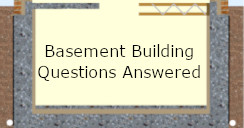
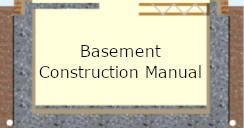
A plant room mini sump for plumbing spills would be a sump held in reserve in case a leak proved incurable, not contradicting BS8102:2022 if the water ingress was only a few litres a year, and not failing building regulation C2 if a tiny leak caused no harm. Click on this image.

|
|
You may be here because your client is concerned you want an insurance backed guarantee.
Insurance backed guarantees have been for internal drainage membrane, sumps and pumps, covering labour and materials only.
But seeing a sump on the drawing incentivised the workforce building the structure to leave leaks. They knew all leaks would be covered over and hidden, and water pumped silently away.
Very sadly, bad and numerous leaks let in mud. Mud has blocked pumps. The Insurance Backed Guarantee was of no use. Basements got mouldy, the occupants ill, and Building Regulation C2 not complied with.
There have been a lot of changes since the Grenfell Tower fire inquiry.
-
BS8102 now says internal drainage is NOT a waterproofing measure, and leaks and damp areas are not acceptable.
-
The Building Safety Act 2022 states that the Principal Designer must ensure work is carried out well. This is usually the architect.
If you, as the Principal Designer allow leaks to be covered over, hidden, with internal drainage, you have probably broken the law.
If the local building control authority learn that the basement flooded and the occupants got ill, even if they didn't do the inspections, they must prosecute your client for instructing an incompetent architect and you must be reported to the new Building Safety Regulator.
Obviously, you will later be sued and lose. As well as all the bad publicity. And your PII !
Structural warranties never included beneath ground waterproofing. There is no need to choose a warranty provider who wants an IBG. Other providers, backed by exactly the same insurer, are available. E.g. Protek and BW Build Warranty.
The solution is a successful inspection. Not Products.
More on issues with structural warranty providers at item 12 in the menu to the right.
|
Supervision.
It would be a mistake, when designing and building a waterproof basement to fully comply with Building Regulation C2 and BS8102:2022, not to specify supervision. Supervision from the start of the design until all leaks are known to be fixed.
My supervision of your design really only means my being as useful as I can. But, on site, my supervision needs to have teeth. That's why it needs to be on the tender drawing that the contractor must do what the supervisor tells them. You might prefer the term Clerk of Works.
Another important rule is, stop inferring into literature or a certificate something the sales rep told you the product does - but isn't in writing. For instance 'we waterproof concrete'. It isn't true, not used beneath ground where it won't bake dry. 'The insulation is fire resistant', 'the sticky-back membrane always sticks', 'the joint strip works', etc. etc. etc.
One more important rule is set in law now.
"pass on necessary information to contractors and explain to them how to demonstrate that elements are built properly."
Building Safety Act 2022. Applies to all projects from October 2023.
Again, this requirement needs to be on the tender drawing where contractors will see it.
In most cases the architect is responsible, as the Principal Designer, for ensuring
"that elements are built properly."
Perhaps you need to insist the client pays for frequent Clerk of Works inspections or a full-time site engineer.
If your client is a self-builder with an education, he can read this web site and I might only supervise concrete pours.
Otherwise, particularly if there is experienced labour, I need to be there almost all the time so they cannot cheat. Or do what they think will do.
Contractors have a lot of bad habits. Habits that were OK before internal drainage was discredited in new habitable accommodation. Bad habits that need ironing out with training on site.
Waterproof concrete is absolutely essential for a new domestic basement about to be built. The Standard says, in Table 2 "Grade 3 no water ingress or damp area is acceptable". Building regulation C2 says it is the floors, walls, and roof that must protect. (Note. Waterproof concrete can only be made. No one can waterproof non-waterproof concrete).
BS8102:2022 states, at 6.2.5, "Continuity of waterproofing protection
The need for continuity in the waterproofing protection should also be determined when selecting a type of protection. In most circumstances, the protection should be continuous (typically from DPC level or 150 mm above ground throughout the below ground structure). "
Only continuous waterproof reinforced concrete can achieve this. See the sketch at the top of every page.
Added together, Building Regulation C2, BS8110, BS8102:2022, the new Building Safety Act 2022, and the New Building Safety Regulator, make it imperative that the design team both ENABLE and DIRECT the contractor AND CLIENT to build a new domestic basement not to leak.
Beware of BBA certificates. Roundly discredited during the Grenfell Tower Inquiry.
BS8102:2022 states that "relevant manufacturers product information should be checked to confirm that the system selected is suitable for the structure to which it is to be applied". A judge summed up 'BBA certificates do not amount to a form of guarantee or a passport to compliance with Building Regulations'. Mulalley and Co v Martlet Homes Ltd (2022). Open the first of two legal pages about this case here.
Your domestic basement design must comply with Building Regulation C2.
From Part C "Site preparation and resistance to contaminants and moisture".
|
|

|

|
|

|
|
In 2023, trying to get to the bottom of what is obviously quite a bit of a mess, I wrote to Dame Judith Hackitt hoping that DLUHC would forward my letter to her. I copied in the Secretary of State, Housing Minister and Parliamentary Committee.
A few months later I got a very useful reply. Click on the thumbnails to see the original.
At this time, the DLUHC would have known about the new regime on its way just a few days later. I didn't.
|
This is very different to what you might think is usual, to smother the outside with sticky-back membrane and cover over the leaks on the inside with a drainage membrane and pump out the water.
Beware of doing what you think everyone else does.
A court judgement made the point that "everyone else was doing it" does not operate as a get out of jail free card. A defendant is not exonerated by simply proving that others were just as negligent.
This was another defence that failed in the Mulalley and Co v Martlet Homes Ltd (2022) case. The summing up referred to a much earlier case, Bolam v Friern Hospital Management Committee (1957). Open the second legal page and scroll down to the fifth paragraph here.
Building Safety Act 2022. This Act gives every party to construction new responsibilities. As you find the Responsibility and Competence that concern you, below.............
bear in mind the very recent Supreme Court judgement, creating clear precedent, that designers can be made to fund remedial work if their design was at fault. Particularly if there is a safety breach.
It seems to me, that if a designer specified an internal drainage system that blocked with mud and there was a flood and illness caused by mould, that this precedent clearly makes that designer responsible for stripping the accommodation back to the structure, repairing leaks and reinstatement. But if the leaks cannot be fixed, then complete replacement of the basement structure.
These few words add a whole new, very practical, site, responsibility to the Principal Designer role. The Principal Designer is responsible for Clerk of Works inspections. The Principal Designer might be wise to appoint a Clerk of Works, me, for the basement structure.
If basement waterproofing fails, Building Regulation C2 is not complied with. The Building Safety Regulator will be after the Principal Designer.

|
|
"pass on necessary information to contractors and explain to them how to demonstrate that elements are built properly."
My warning sign is because anything you tell the main contractor to pass on to the sub-contractor's sub-contractor's tradesman won't reach him. He will tell someone he will read it, but I promise you he won't have the capacity to understand or take it in, if he reads it.
|
He has to be shown. That is how he learnt everything he knows. He was shown.
And, a CSSW, who has no valid waterproofing measure to sell you, is NOT a new-build domestic basement waterproofing specialist, despite the plainly wrong advice from NHBC, Premier Guarantee, LABC Warranty and other warranty providers.
If a design detail lets in leaks; the architect risks sanctions from the new Building Safety Regulator; and their client faces a criminal trial in court for choosing an incompetent architect.
NHBC guidance is wrong. Premier Guarantee guidance is wrong. LABC Warranty guidance is wrong.
They all make you let the water in and pump the water out. For years, from 2009 probably, their advice, that they insist you adopt, has caused architects to contravene Building Regulation C2.
Do you have problems with PII for basements ? Now you know why.
This is what the new regime will prevent.
Every "professional" contractor will leave holes through plastic tubes after they withdraw the steel threaded rod to keep re-using it. The number of holes they will fill ranges from zero to about 90%. What they will not do is make sure they fill every hole to be waterproof - because architects have always put a sump and a pump on the drawing.
The sump and the pump are the root cause of bad workmanship.
|
|
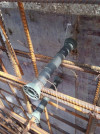
|
|
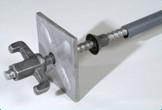
|
|
As this image shows, if you let an internal drainage system company in,
and their CSSW who spent 4 days in a classroom to become your expert, your waterproofing specialist,
they won't wait. They will cover the leaks over long before the structure is weathertight. They won't let you check for leaks. They won't let you fix leaks. They won't let you comply with Building Regulation C2.
And, when mud blocks the pumps, and rain persists, the basement will flood.
Mould. Harm.
The client or developer will be prosecuted for instructing you beyond your competence.
The architect will face the wrath of the new Building Safety Regulator.
Building control will face the wrath of the Building Safety Regulator as well.
Then there will be a claim.
|

|
Leaks cannot all be identified and fixed until after the structure is completely weathertight, it has been cleaned and dried, and inspected before anything covers the basement inside. Because it fills up with rain and muck as soon as the wall formwork is put up.
Internal drainage suppliers do not include cleaning and fixing leaks in their scope of works.
They might say they will paint the inside with a waterproof paint, or render. But neither would stick where a leak of water is pushing it off.
Products from internal drainage suppliers, including tapes and strips, renders, copolymer paints and so on, do not waterproof leaking structures.
Unless you fix all the leaks first, they don't work.
If you fix all the leaks first you don't need any of them.
That's why none of them are waterproofing specialists.
|

|
Three further options as second defences against ingress of water.
My name is Phillip Sacre.
I have built and helped clients building a waterproof basement for years. I promised a genuinely waterproof concrete structure and I had to overcome the design details and BBA certified products that did not work.
Not a drip has got through or over any basement structure built my way since 2013. Despite the very poor ideas specified by architects in response to advice from CSSW surveyors.
None of my clients have an internal drainage system.
They all have a dry basement. Dry from the concrete alone.
The three options available as a second defence against ingress of water are
-
External drainage if it is maintainable and always drains away by gravity. Actually, a no-brainer if it will always work.
-
Waterproof paint all over the inside of the basement - but this only adheres where there is no leak, no matter how slight. And only if each coat is thin enough to dry against the substrate before a skin dries on the surface. Great care is required.
-
A very tiny internal drainage system that might be there primarily for plumbing spills, but would double up to remove extremely minor leaks that were missed during inspection.
My internal drainage.
This is a shallow tray I cast in a structural floor slab during 2012, positioned in the plant room to help deal with plumbing spills.
This client decided to put drainage membrane over the floor before his basement floor insulation. He did this himself.
The 25mm deep tray is in the waterproof, reinforced, structural concrete.

|
|
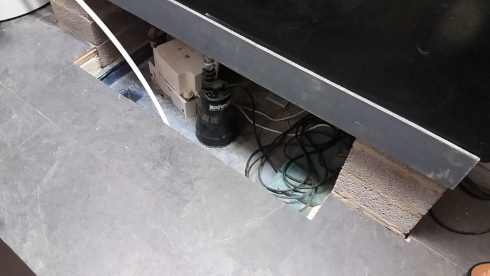
|
This is the sump for a few litres of water a year. It can be specified and used if required. Or not used if the basement is dry. Or, my preference, not fitted out, just fitted with a water sensing alarm. If the alarm sounds, mop up the puddle with a rag.
But, what was important, was that the workforce did not expect it to deal with leaks. They had to do their work well.
2024 and I came across this puddle pump with a built in water sensor, instead of a float switch, that pumps to within 1mm.
Here it is installed as a retro fit because the basement for the swimming pool was allowed to fill up with rain before the roof was fitted over it, and the void sealed off with beam and block flooring. The client determined it should be dry.
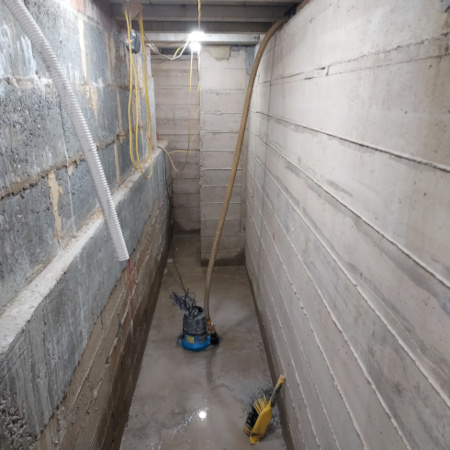
|
|
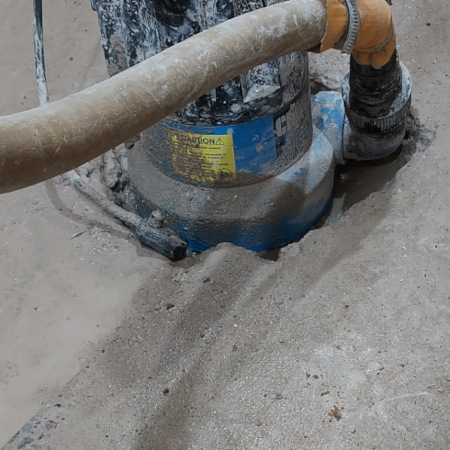
|
The shorter and narrower the discharge pipe, the less water runs back down when the pump automatically switches off. I used an old compressed air pipe and I put two lengths of 3-core electric flex cables through it, to reduce the capacity of the pipe.
About 2009 I built a basement and the client wanted a structural warranty from NHBC.
NHBC wanted an insurance backed guarantee. (IBG)
I found an insurer, QANW, who backed my personal guarantee that the basement would not leak.
It required careful, supervised workmanship and a sign-off after heavy rain by the IBG Inspector. The policy was then assigned to NHBC.
The architect needs to organise the structural warranty today to, preferably, not need an IBG for beneath ground waterproofing because the structural warranty excludes it; or else a policy covering the waterproof concrete.
Concrete can be tested to prove it is waterproof when it arrives at site.
The test to prove concrete is waterproof.
if the basement is to be inspected before the inside is covered with anything, this should be the criteria
-
After the basement is finished it should not be fitted out until after the architect and all other interested parties, such as building control and warranty providers, have inspected and each signed it off.
-
They should not inspect until after
-
The roof and windows are in and the structure is fully weather-tight,
-
the basement has been emptied of rain water, cleaned and dried, (probably ventilated as well),
-
the contractor has stopped all leaks into the basement,
-
and just after a period of heavy rain.
The main contractor is responsible for the structure, continuous from the base of the basement structural floor slab to 150mm above outside ground level, to not leak at all, for a period of 6 years from practical completion.
|
I was given a copy of a quotation by Maclennan Waterproofing dated 31st May 2023.
A standard sentence in the introduction is:
|
|

|
and this is from the same Maclennan quotation.
"As BS8102:2022 (Protection of below ground structures against water ingress - code of practice) recommends two forms of waterproofing, with the current design we would use an externally applied membrane and cavity drain to comply. But if shuttered RC concrete wall adopted for the walls then we could change the design to Crystalcoat in leiu of the external membrane system.
A cavity drain system would be fitted inside the walls and floor."
They don't specifically claim that internal drainage is a waterproofing measure, which BS8102:2022 states it isn't. But is that what you understood the first time you read it?
External drainage is, subject to suitable conditions and maintenance (rodding eyes or inspection chambers), a good waterproofing measure.
Sticky-back membrane is a poor waterproofer. The Standard says sticky-back membrane should only be applied to impermeable surfaces. It might happen to work where concrete has a crack.
The Crystalcoat will be basically some cement powder that gets mixed with water and painted or rubbed on to the concrete. The idea is that it will slightly penetrate the surface of porous concrete where it will set and improve the density of the surface, slightly increasing its resistance to water penetration. But it isn't going to magically fix cracks or voids the result of poor workmanship. Nor seal joints. It might reverse much of the bad effect of too much water in the concrete after the workers added more water to the concrete when it arrived. But it cannot cure poor concrete placement or poor compaction.
Neither do they say they will fill holes if the contractor left the tie bar plastic tubes through the walls without filling them.
Their two, valid, approved, defences are the external drainage and the structural concrete they improved but did not repair, but not if there are still leaking tie bar holes, honeycombing, leaking kickers and so on. And not if external drainage cannot drain away.
Internal drainage is allowed only in non-habitable accommodation (e.g. workshop, car parking) if leaks are reduced to seepage or less. It may only be designed to cope with seepage or less. It is not a waterproofer. Maclennan don't mention reducing leaks to seepage or less but they have specified a massive internal drainage system with inspection ports to check whether the internal drainage channel is blocking up with debris washed in through obvious leaks.
These are all serious breaches of BS8102. Ian Maclennan knows full well he is being dishonest.
I know about this stuff. Yet I found it very difficult to properly understand what they were saying just in the sentences I reproduced in
blue above. Did you?
The problem for Maclennan Waterproofing is that they are a major part of the problem, and if BS8102 is properly followed they will lose a very large chunk of their business. They are lying to preserve it.
But I think they want an inexperienced eye to conclude that their internal drainage system is both essential and compliant - despite their not saying it is.
I think that to an inexperienced eye they want internal drainage to be taken as one of two defences.
And they want the reader to believe that because Ian Maclennan wrote the new BS8102 that this is exactly what the new basement specification needs to include.
But I think it is a whole lot of lies and I think architects will get themselves into trouble accepting these proposals.
It would be a mistake if you allowed your mind to imply wording into the Maclennan quotation that isn't actually there.
The quotation PDF document is too large for this web server. If you would like to see the original, please just email me and ask me to send it to you.
|
Be in no doubt. CSSW surveyors and the internal drainage system suppliers that employ them, and who largely wrote the 2009 Standard, are the root cause. As well as NHBC that still gives you little alternative but to use a CSSW. Everyone who follows NHBC instead of the Building Regulations is at grave risk of losing a claim - and their PII. BS8102 recognised the overdue need for change. The Building Safety Act 2022 takes change even further. CSSW surveyors are not the expert you need to listen to. They get no mention in BS8102:2022.
The British Standard has changed significantly. Internal drainage for a new build basement is all but forbidden. Bad choices of product: beam and block and sticky-back membrane should be avoided. Other products, such as ICF and twin wall precast concrete (such as Glatthaar Keller) "should be deemed inherently high risk." See 5.1.3 of the Standard.
Instead, the building of the structure should be supervised and repaired until it does not leak - before any fitting out of the basement.
The architect should not choose a CSSW surveyor from an internal drainage company to be the Waterproofing Specialist if the project is not a Victorian cellar.
They should choose someone suitably qualified and experienced at the civil engineering involved in constructing an underground structure that is waterproof, and, in the majority of cases, internal drainage should not be installed in a new basement.
I can be the Waterproofing Specialist on the Design Team.
|
These usual choices by architects are not popular in BS8102:2022 and should probably never be chosen for a new basement.
-
External render or external sticky-back membrane.
If either external render or membrane are specified, they are not to be relied upon as fully waterproof. Render cracks. Membranes fail to stick. Either may luckily prevent a leak. But they might not prevent all leaks.
They can be damaged too easily by following-on trades and processes. They could not be continuous from the base of the floor slab to well above outside ground level. Neither of these product types work reliably across structural joints, for instance, over the ends of beam and block flooring.
The inside of the basement structure will still need repairing if there is water ingress despite an external render or external membrane.
-
Waterproof paint all over the inside of the basement structure.
This must only be applied after the sign off by all interested parties that there is zero water coming through the structure. Or, conceivably, before the basement is backfilled and before there is any water outside to leak through.
In the hands of a labourer, waterproof paint will not work.
If there is any ingress of water, no matter how slight, coming through the surface to be painted, waterproof paint will not dry or adhere.
Manufacturers specify 3 coats. I have found that when I apply waterproof paint I apply about 9 coats before I am satisfied, and every coat is thin so that the base of each coat dries before the surface of each coat dries which would prevent the surface of the wet paint adhering to what is beneath.
This will also need inspecting and signing off, but perhaps only by the architect or a clerk of works.
-
Internal drainage. But only if total ingress of water is no more than 'seepage' and all interested parties agree. Otherwise leak repairs must continue.
IT IS ESSENTIAL THAT THERE IS NO MENTION OF INTERNAL DRAINAGE ON ANY DRAWING FOR TENDER THROUGH TO CONSTRUCTION.
NO EXCUSE FOR SITE TEAMS NOT TO TAKE UTMOST CARE.
Note. 'seepage' should not amount to more than a few litres of water a year. A sump need be no bigger than a few litres. A shallow tray cast in the structural floor slab. Described on the drawing as only an aid to clearing up plumbing spills.
You will have had presentations telling you that you must specify internal drainage because of a particular court case.
The Outwing Construction v Thomas Weatherald (1999) case here.
But I think you have been misled by unscrupulous sales people.
The architects for the Grenfell Tower were misled by unscrupulous sales people.
Unscrupulous organisations that cheated the testing, withheld important information, knowingly lied.
Outwing Construction. 1999.
When the basement leaked the main contractor withheld money that the sub contractor, Outwing, successfully sued to be paid.
|
|
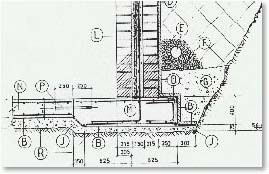
|
The situation: The design required 2 skins of blockwork wall filled with concrete to be the retaining wall, covered on the outside with a sticky-back waterproof membrane and in front of that a land drain some way up the wall, not at the bottom. The ground outside was chalk.
The judge agreed that the sticky back membrane outside was not suitable if it were to sit in water and the land drain should have been much lower beneath the concrete slab/wall joint.
If external drainage wasn't going to work then he said that a better solution needed to be chosen.
Nowhere does the judgement say internal drainage, a sump, pump, backup pump or emergency power source needed to be specified.
In my experience, the experience that meant I became a basement expert:
-
Two skins of blockwork would both leak and the concrete in between could never be waterproof because the void could not be cleaned of mortar that dropped inside when the blocks were laid, or the joint cleaned or a joint strip protected.
-
Sticky-back membrane rarely sticks successfully to a basement wall because the atmosphere on the north side down an excavation is usually too moist, which is enough to stop these products sticking even to primer.
-
The designer may have thought that chalk would always drain anyway, and the drainage superfluous.
|
It would seem to me this case could be read 3 different ways, not just the one way that suits the suppliers that sell the most expensive solutions:
-
This ruling means that a sub contractor cannot have money withheld if he does work badly.
or
-
A basement waterproofing design can only be valid if the waterproofing can be repaired during the life of the basement
AND
the design will be robust even with water outside 1m deep.
or
-
This design was particularly poor and so likely to fail that the sub contractor could not be blamed.
Without any doubt, this third way of reading the case is the correct way to read it. Not that basements need up to £40,000 of internal drainage to cope with leaks through this obviously very poor design.
I think that in this case a good soakaway should have been possible in the chalk, the land drain should have been much lower beside the slab and the retaining walls solid reinforced, waterproof concrete checked and repaired before the basement was fitted out.
|
Back to the Basement Building Questions Answered menu.

|
Forward to the Basement Building Construction Manual menu.

|
For a fixed fee of £199 I will answer all your questions by email. More details here.

|
Previous Page

|
|
Next Page
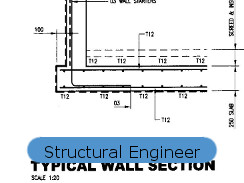
|
|
The Page After That
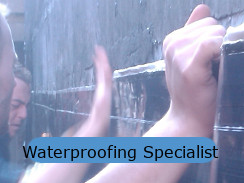
|
|
|
|

